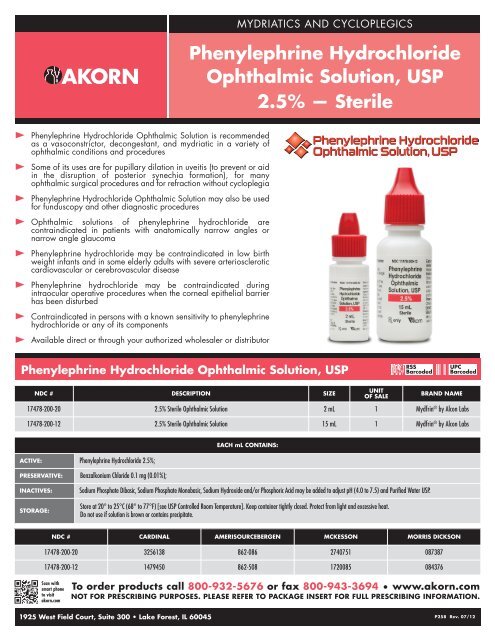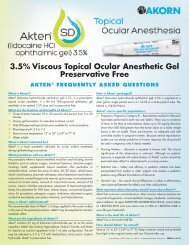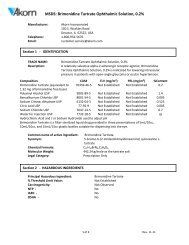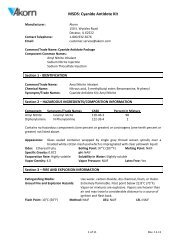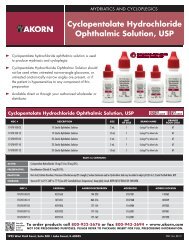Layout 1
Layout 1
Layout 1
Create successful ePaper yourself
Turn your PDF publications into a flip-book with our unique Google optimized e-Paper software.
Phenylephrine Hydrochloride Ophthalmic Solution is recommended<br />
as a vasoconstrictor, decongestant, and mydriatic in a variety of<br />
ophthalmic conditions and procedures<br />
Some of its uses are for pupillary dilation in uveitis (to prevent or aid<br />
in the disruption of posterior synechia formation), for many<br />
ophthalmic surgical procedures and for refraction without cycloplegia<br />
Phenylephrine Hydrochloride Ophthalmic Solution may also be used<br />
for funduscopy and other diagnostic procedures<br />
Ophthalmic solutions of phenylephrine hydrochloride are<br />
contraindicated in patients with anatomically narrow angles or<br />
narrow angle glaucoma<br />
Phenylephrine hydrochloride may be contraindicated in low birth<br />
weight infants and in some elderly adults with severe arteriosclerotic<br />
cardiovascular or cerebrovascular disease<br />
Phenylephrine hydrochloride may be contraindicated during<br />
intraocular operative procedures when the corneal epithelial barrier<br />
has been disturbed<br />
Contraindicated in persons with a known sensitivity to phenylephrine<br />
hydrochloride or any of its components<br />
Available direct or through your authorized wholesaler or distributor<br />
Phenylephrine Hydrochloride<br />
Ophthalmic Solution, USP<br />
2.5% — Sterile<br />
Phenylephrine Hydrochloride Ophthalmic Solution, USP<br />
NDC # DESCRIPTION SIZE<br />
UNIT<br />
OF SALE<br />
BRAND NAME<br />
17478-200-20 2.5% Sterile Ophthalmic Solution 2 mL 1 Mydfrin ® by Alcon Labs<br />
17478-200-12 2.5% Sterile Ophthalmic Solution 15 mL 1 Mydfrin ® by Alcon Labs<br />
ACTIVE: Phenylephrine Hydrochloride 2.5%;<br />
PRESERVATIVE: Benzalkonium Chloride 0.1 mg (0.01%);<br />
EACH mL CONTAINS:<br />
INACTIVES: Sodium Phosphate Dibasic, Sodium Phosphate Monobasic, Sodium Hydroxide and/or Phosphoric Acid may be added to adjust pH (4.0 to 7.5) and Purified Water USP.<br />
STORAGE:<br />
MYDRIATICS AND CYCLOPLEGICS<br />
Store at 20° to 25°C (68° to 77°F) [see USP Controlled Room Temperature]. Keep container tightly closed. Protect from light and excessive heat.<br />
Do not use if solution is brown or contains precipitate.<br />
NDC # CARDINAL AMERISOURCEBERGEN MCKESSON MORRIS DICKSON<br />
17478-200-20 3256138 862-086 2740751 087387<br />
17478-200-12 1479450 862-508 1720085 084376<br />
Scan with<br />
smart phone<br />
to visit<br />
akorn.com<br />
To order products call 800-932-5676 or fax 800-943-3694 • www.akorn.com<br />
NOT FOR PRESCRIBING PURPOSES. PLEASE REFER TO PACKAGE INSERT FOR FULL PRESCRIBING INFORMATION.<br />
1925 West Field Court, Suite 300 • Lake Forest, IL 60045<br />
P258 Rev. 07/12
Phenylephrine Hydrochloride<br />
Ophthalmic Solution, USP<br />
2.5% — Sterile<br />
WARNING: PHYSICIANS SHOULD COMPLETELY<br />
FAMILIARIZE THEMSELVES WITH THE COMPLETE<br />
CONTENTS OF THIS LEAFLET BEFORE PRESCRIBING<br />
PHENYLEPHRINE HYDROCHLORIDE OPHTHALMIC<br />
SOLUTION.<br />
DESCRIPTION: Phenylephrine Hydrochloride Ophthalmic<br />
Solution, USP is a vasoconstrictor and mydriatic for use in<br />
ophthalmology. Phenylephrine is a synthetic sympathomimetic<br />
compound structurally similar to epinephrine and ephedrine.<br />
Phenylephrine Hydrochloride Ophthalmic Solution is supplied<br />
as a sterile topical ophthalmic solution. The active ingredient,<br />
phenylephrine hydrochloride is represented by the chemical<br />
structure:<br />
ESTABLISHED NAME: Phenylephrine Hydrochloride<br />
CHEMICAL NAME: ( -) -m-Hydroxy-α-[(methyl -amino)methyl]<br />
benzyl alcohol hydrochloride<br />
Each mL of solution contains:<br />
Active: Phenylephrine Hydrochloride 2.5%. Inactives: Sodium<br />
Phosphate Dibasic, Sodium Phosphate Monobasic, Sodium<br />
Hydroxide and/or Phosphoric Acid may be added to adjust pH<br />
(4.0 to 7.5), and Purified Water USP. Preservative:<br />
Benzalkonium Chloride 0.1 mg (0.01%).<br />
CLINICAL PHARMACOLOGY:<br />
Phenylephrine Hydrochloride Ophthalmic Solution is an alpha<br />
receptor sympathetic agonist used in local ocular disorders<br />
because of its vasoconstrictor and mydriatic action. It exhibits<br />
rapid and moderately prolonged action, and it produces little<br />
rebound vasodilation. Systemic side effects are uncommon.<br />
Although rare, systemic absorption of sufficient quantities of<br />
phenylephrine may lead to systemic α-adrenergic affects, such<br />
as a rise in blood pressure which may be accompanied by a<br />
reflex atropine -sensitive bradycardia.<br />
INDICATIONS AND USAGE: Phenylephrine Hydrochloride<br />
Ophthalmic Solution is recommended as a vasoconstrictor,<br />
decongestant, and mydriatic in a variety of ophthalmic<br />
conditions and procedures. Some of its uses are for pupillary<br />
dilation in uveitis (to prevent or aid in the disruption of posterior<br />
synechia formation), for many ophthalmic surgical procedures<br />
and for refraction without cycloplegia. Phenylephrine<br />
Hydrochloride Ophthalmic Solution may also be used for<br />
funduscopy and other diagnostic procedures.<br />
CONTRAINDICATIONS: Ophthalmic solutions of phenylephrine<br />
hydrochloride are contraindicated in patients with anatomically<br />
narrow angles or narrow angle glaucoma. Phenylephrine<br />
hydrochloride may be contraindicated in low birth weight<br />
infants and in some elderly adults with severe arteriosclerotic<br />
cardiovascular or cerebrovascular disease. Phenylephrine<br />
hydrochloride may be contraindicated during intraocular<br />
operative procedures when the corneal epithelial barrier has<br />
been disturbed. This preparation is also contraindicated in<br />
persons with a known sensitivity to phenylephrine<br />
hydrochloride or any of its components.<br />
WARNINGS: Not for intraocular use. As with other adrenergic<br />
drugs, when Phenylephrine Hydrochloride Ophthalmic Solution<br />
is administered simultaneously with, or up to 21 days after,<br />
administration of monoamine oxidase (MAO) inhibitors, careful<br />
supervision and adjustment of dosages are required since<br />
exaggerated adrenergic effects may result. The pressor<br />
response of adrenergic agents may also be potentiated by<br />
tricyclic antidepressants. Systemic side effects are more<br />
common in patients taking beta adrenergic blocking agents<br />
such as propranolol. Concomitant use of phenylephrine and<br />
atropine may enhance the pressor effects and induce<br />
tachycardia in some patients, especially infants. 1<br />
There have been rare reports associating the use of<br />
phenylephrine hydrochloride 10% ophthalmic solutions with<br />
the development of serious cardiovascular reactions, including<br />
ventricular arrhythmias and myocardial infarctions. These<br />
episodes, some ending fatally, have usually occurred in elderly<br />
patients with preexisting cardiovascular diseases.<br />
PRECAUTIONS:<br />
General: Ordinarily, any mydriatic, including phenylephrine<br />
hydrochloride, is contraindicated in patients with glaucoma,<br />
since it may occasionally raise intraocular pressure. However,<br />
when temporary dilation of the pupil may free adhesions, this<br />
advantage may temporarily outweigh the danger from<br />
coincident dilation of the pupil. Rebound miosis has been<br />
reported in older persons one day after receiving phenylephrine<br />
hydrochloride ophthalmic solutions, and reinstillation of the<br />
drug may produce less mydriasis than previously. This may be<br />
of clinical importance in dilating the pupils of older subjects<br />
prior to retinal detachment or cataract surgery. The lacrimal<br />
sac should be compressed by digital pressure for two to three<br />
minutes after instillation to avoid excessive systemic<br />
absorption. Due to a strong action of the drug on the dilator<br />
muscle, older individuals may also develop transient pigment<br />
floaters in the aqueous humor 40 to 45 minutes following the<br />
administration of phenylephrine hydrochloride ophthalmic<br />
solution. The appearance may be similar to anterior uveitis or<br />
to a microscopic hyphema. To prevent pain, a drop of suitable<br />
topical anesthetic may be applied before using Phenylephrine<br />
Hydrochloride Ophthalmic Solution. Prolonged exposure to air<br />
or strong light may cause oxidation and discoloration. Monitor<br />
blood pressure in geriatric patients with known cardiac disease.<br />
Use caution in infants with known cardiac anomalies.<br />
Exceeding recommended dosages or applying Phenylephrine<br />
Hydrochloride Ophthalmic Solution to the instrumented,<br />
traumatized, diseased or postsurgical eye or adnexa, or to<br />
patients with suppressed lacrimation, as during anesthesia,<br />
may result in the absorption of sufficient quantities of<br />
phenylephrine to produce a systemic vasopressor response.<br />
INFORMATION FOR PATIENTS: DO NOT TOUCH DROPPER<br />
TIP TO ANY SURFACE AS THIS MAY CONTAMINATE THE<br />
SOLUTION. DO NOT USE IF SOLUTION IS BROWN OR<br />
CONTAINS A PRECIPITATE.<br />
Drug Interaction: As with all other adrenergic drugs, when<br />
Phenylephrine Hydrochloride Ophthalmic Solution is administered<br />
simultaneously with, or up to 21 days after, administration of<br />
monoamine oxidase (MAO) inhibitors, careful supervision and<br />
adjustment of dosages are required since exaggerated adrenergic<br />
effects may occur. The pressor response of adrenergic agents may<br />
also be potentiated by tricyclic antidepressants, propranolol,<br />
reserpine, guanethidine, methyldopa, and atropine- like drugs.<br />
Phenylephrine hydrochloride ophthalmic solutions may potentiate<br />
the cardiovascular depressant effects of potent inhalation<br />
anesthetic agents.<br />
Carcinogenesis, Mutagenesis, Impairment of Fertility:<br />
Carcinogenicity studies with phenylephrine hydrochloride have<br />
been completed in mice at doses up to 2500 ppm in feed and<br />
in rats at doses up to 1250 ppm in feed. Phenylephrine<br />
hydrochloride demonstrated no carcinogenic effect in male or<br />
female mice and rats.<br />
Pregnancy: Pregnancy Category C. Animal reproduction<br />
studies have not been conducted with phenylephrine<br />
hydrochloride ophthalmic solution. It is also not known<br />
whether phenylephrine hydrochloride ophthalmic solution can<br />
cause fetal harm when administered to a pregnant woman or<br />
can affect reproduction capacity. Phenylephrine Hydrochloride<br />
Ophthalmic Solution should be given to a pregnant woman<br />
only if clearly needed.<br />
Nursing Mothers: It is not known whether this drug is excreted<br />
in human milk. Because many drugs are excreted in human<br />
milk, caution should be exercised when Phenylephrine<br />
Hydrochloride Ophthalmic Solution is administered to a<br />
nursing woman.<br />
Pediatric Use: Phenylephrine Hydrochloride Ophthalmic<br />
Solution may be contraindicated in low birth weight neonates<br />
and infants. For use in older children see DOSAGE AND<br />
ADMINISTRATION.<br />
Exceeding recommended dosages or applying Phenylephrine<br />
Hydrochloride Ophthalmic Solution to the instrumented,<br />
traumatized, diseased or post surgical eye or adnexa, or to<br />
patients with suppressed lacrimation, as during anesthesia,<br />
may result in the absorption of sufficient quantities of<br />
phenylephrine to produce a systemic vasopressor response.<br />
The hypertensive effects of phenylephrine may be treated with<br />
an alpha -adrenergic blocking agent such as phentolamine<br />
mesylate, 5 mg to 10 mg intravenously, repeated as necessary.<br />
The oral LD 50 of phenylephrine in the rat: 350 mg/kg, in the<br />
mouse: 120 mg/kg.<br />
Concomitant use of phenylephrine and atropine may enhance<br />
the pressor effects and induce tachycardia in some patients,<br />
especially infants.<br />
Use with caution in infants with known cardiac anomalies.<br />
ADVERSE REACTIONS: A marked increase in blood pressure<br />
has been reported in low- weight premature neonates, infants<br />
and adult patients with idiopathic orthostatic hypotension.<br />
Cardiovascular reactions which have occurred primarily in<br />
elderly patients include marked increase in blood pressure,<br />
syncope, myocardial infarction, tachycardia, arrhythmia, and<br />
fatal subarachnoid hemorrhage. 2<br />
Other reactions include bradycardia, headache, and excitability.<br />
DOSAGE AND ADMINISTRATION:<br />
Vasoconstriction and Pupil Dilatation: Phenylephrine<br />
Hydrochloride Ophthalmic Solution is especially useful when<br />
rapid and powerful dilatation of the pupil without cycloplegia<br />
and reduction of congestion in the capillary bed are desired. A<br />
drop of a suitable topical anesthetic may be applied, followed<br />
in a few minutes by 1 drop of Phenylephrine Hydrochloride<br />
Ophthalmic Solution to the upper limbus. The anesthetic<br />
prevents stinging and consequent dilution of the solution by<br />
lacrimation. It may occasionally be necessary to repeat the<br />
instillation after one hour, again preceded by the use of the<br />
topical anesthetic.<br />
Uveitis: Posterior Synechiae: Phenylephrine Hydrochloride<br />
Ophthalmic Solution may be used in patients with uveitis when<br />
synechiae are present or may develop. The formation of<br />
synechiae may be prevented by the use of this solution and<br />
atropine or other cycloplegics to produce wide dilation of the<br />
pupil. For recently formed posterior synechiae one drop of<br />
Phenylephrine Hydrochloride Ophthalmic Solution may be<br />
applied to the upper surface of the cornea and be repeated as<br />
necessary, not to exceed three times. Treatment may be<br />
continued the following day, if necessary. Atropine sulfate and<br />
the application of hot compresses should also be used if<br />
indicated.<br />
Glaucoma: Phenylephrine Hydrochloride Ophthalmic Solution<br />
may be used with miotics in patients with open angle<br />
glaucoma. It reduces the difficulties experienced by the patient<br />
because of the small field produced by miosis, and still it<br />
permits and often supports the effect of the miotic in lowering<br />
the intraocular pressure in open angle glaucoma. Hence, there<br />
may be marked improvement in visual acuity after using<br />
Phenylephrine Hydrochloride Ophthalmic Solution in<br />
conjunction with miotic drugs.<br />
Surgery: When a short -acting mydriatic is needed for wide<br />
dilation of the pupil before intraocular surgery, Phenylephrine<br />
Hydrochloride Ophthalmic Solution may be applied topically<br />
from 30 to 60 minutes before the operation.<br />
Refraction: Phenylephrine Hydrochloride Ophthalmic Solution<br />
may be used effectively to increase mydriasis with homatropine<br />
hydrobromide, cyclopentolate hydrochloride, tropicamide<br />
hydrochloride and atropine sulfate.<br />
FOR ADULTS: One drop of the preferred cycloplegic is<br />
placed in each eye, followed in 5 minutes by one drop<br />
of Phenylephrine Hydrochloride Ophthalmic Solution.<br />
Since adequate cycloplegia is achieved at different time<br />
intervals after the instillation of the necessary number<br />
of drops, different cycloplegics will require different<br />
waiting periods to achieve adequate cycloplegia.<br />
FOR CHILDREN: For a “one application method,”<br />
Phenylephrine Hydrochloride Ophthalmic Solution may<br />
be combined with one of the preferred rapid acting<br />
cycloplegics to produce adequate cycloplegia.<br />
Opthalmoscopic Examination: One drop of Phenylephrine<br />
Hydrochloride Ophthalmic Solution is placed in each eye.<br />
Sufficient mydriasis to permit examination is produced in 15 to<br />
30 minutes. Dilation lasts one to three hours.<br />
Diagnostic Procedures:<br />
Provocative Test for Angle Closure Glaucoma:<br />
Phenylephrine Hydrochloride Ophthalmic Solution may be<br />
used cautiously as a provocative test when interval narrow<br />
angle closure glaucoma is suspected. Intraocular tension and<br />
gonioscopy are performed prior to and after dilation of the pupil<br />
with phenylephrine hydrochloride. A “significant” intraocular<br />
pressure (IOP) rise combined with gonioscopic evidence of<br />
angle closure indicates an anterior segment anatomy capable<br />
of angle closure. A negative test does not rule this out. This<br />
pharmacologically induced angle closure glaucoma may not<br />
simulate real life conditions and other causes for transient<br />
elevations of IOP should be excluded.<br />
Retinoscopy (Shadow Test): When dilation of the pupil without<br />
cycloplegic action is desired for retinoscopy, Phenylephrine<br />
Hydrochloride Ophthalmic Solution may be used.<br />
NOTE: Heavily pigmented irides may require larger doses in all<br />
of the above procedures.<br />
Blanching Test: One or two drops of Phenylephrine<br />
Hydrochloride Ophthalmic Solution should be applied to the<br />
injected eye. After five minutes, examine for perilimbal<br />
blanching. If blanching occurs, the congestion is superficial<br />
and probably does not indicate iridocyclitis.<br />
HOW SUPPLIED: Phenylephrine Hydrochloride Ophthalmic<br />
Solution, USP is supplied as a sterile solution in plastic dropper<br />
bottles in the following sizes:<br />
2 mL -NDC 17478 -200- 20<br />
15 mL -NDC 17478- 200- 12<br />
Storage: Store at 20° to 25°C (68° to 77°F) [see USP<br />
Controlled Room Temperature]. Keep container tightly closed.<br />
Protect from light and excessive heat.<br />
Do not use if solution is brown or contains precipitate.<br />
REFERENCES:<br />
1. Fraunfelder, F.T., and Meyer, S.M.: Possible Cardiovascular<br />
Effects Secondary to Topical Ophthalmic 2.5%<br />
Phenylephrine, Am. J. Oph. 99:3:362, 1985.<br />
2. Ibid.<br />
DLA0N Rev. 07/11
Phenylephrine Hydrochloride Ophthalmic Solution is recommended<br />
as a vasoconstrictor, decongestant, and mydriatic in a variety of<br />
ophthalmic conditions and procedures<br />
Some of its uses are for pupillary dilation in uveitis (to prevent or aid<br />
in the disruption of posterior synechia formation), for many<br />
ophthalmic surgical procedures<br />
Ophthalmic solutions of phenylephrine hydrochloride are<br />
contraindicated in patients with anatomically narrow angles or<br />
narrow angle glaucoma<br />
Phenylephrine hydrochloride is contraindicated in infants and in<br />
some elderly adults with severe arteriosclerotic cardiovascular or<br />
cerebrovascular disease<br />
Phenylephrine hydrochloride may be contraindicated during<br />
intraocular operative procedures when the corneal epithelial barrier<br />
has been disturbed<br />
Contraindicated in persons with a known sensitivity to phenylephrine<br />
hydrochloride or any of its components<br />
Available direct or through your authorized wholesaler or distributor<br />
Phenylephrine Hydrochloride<br />
Ophthalmic Solution, USP<br />
10% — Sterile<br />
Phenylephrine Hydrochloride Ophthalmic Solution, USP<br />
NDC # DESCRIPTION SIZE<br />
UNIT<br />
OF SALE<br />
BRAND NAME<br />
17478-205-10 10% Sterile Ophthalmic Solution 5 mL 1 Mydfrin ® by Alcon Labs<br />
ACTIVE: Phenylephrine Hydrochloride 10%;<br />
PRESERVATIVE: Benzalkonium Chloride 0.1 mg (0.01%);<br />
EACH mL CONTAINS:<br />
INACTIVES: Sodium Phosphate Dibasic, Sodium Phosphate Monobasic, Sodium Hydroxide and/or Phosphoric Acid may be used to adjust pH (4.0 to 7.5) and Purified Water USP.<br />
STORAGE:<br />
MYDRIATICS AND CYCLOPLEGICS<br />
Store at 20° to 25°C (68° to 77°F) [see USP Controlled Room Temperature]. Keep container tightly closed. Protect from light and excessive heat.<br />
Do not use if solution is brown or contains precipitate.<br />
NDC # CARDINAL AMERISOURCEBERGEN MCKESSON MORRIS DICKSON<br />
17478-205-10 1465293 862-375 1603885 084616<br />
Scan with<br />
smart phone<br />
to visit<br />
akorn.com<br />
To order products call 800-932-5676 or fax 800-943-3694 • www.akorn.com<br />
NOT FOR PRESCRIBING PURPOSES. PLEASE REFER TO PACKAGE INSERT FOR FULL PRESCRIBING INFORMATION.<br />
1925 West Field Court, Suite 300 • Lake Forest, IL 60045<br />
P258 Rev. 07/12
Phenylephrine Hydrochloride<br />
Ophthalmic Solution, USP<br />
10% — Sterile<br />
WARNING: PHYSICIANS SHOULD COMPLETELY<br />
FAMILIARIZE THEMSELVES WITH THE COMPLETE<br />
CONTENTS OF THIS LEAFLET BEFORE PRESCRIBING<br />
PHENYLEPHRINE HYDROCHLORIDE OPHTHALMIC<br />
SOLUTION.<br />
DESCRIPTION: Phenylephrine Hydrochloride Ophthalmic<br />
Solution, USP is a vasoconstrictor and mydriatic for use in<br />
ophthalmology. Phenylephrine is a synthetic sympathomimetic<br />
compound structurally similar to epinephrine and ephedrine.<br />
Phenylephrine Hydrochloride Ophthalmic Solution is supplied<br />
as a sterile topical ophthalmic solution. The active ingredient,<br />
phenylephrine hydrochloride is represented by the chemical<br />
structure:<br />
ESTABLISHED NAME: Phenylephrine Hydrochloride<br />
CHEMICAL NAME: ( -) -m-Hydroxy-α-[(methyl -amino)methyl]<br />
benzyl alcohol hydrochloride<br />
Each mL of solution contains:<br />
Active: Phenylephrine Hydrochloride 10%. Inactives: Sodium<br />
Phosphate Dibasic, Sodium Phosphate Monobasic, Sodium<br />
Hydroxide and/or Phosphoric Acid may be used to adjust pH<br />
(4.0 to 7.5) and Purified Water USP q.s. Preservative:<br />
Benzalkonium Chloride 0.1 mg (0.01%).<br />
CLINICAL PHARMACOLOGY:<br />
Phenylephrine Hydrochloride Ophthalmic Solution is an alpha<br />
receptor sympathetic agonist used in local ocular disorders<br />
because of its vasoconstrictor and mydriatic action. It exhibits<br />
rapid and moderately prolonged action, and it produces little<br />
rebound vasodilation. Systemic side effects are uncommon.<br />
Although rare, systemic absorption of sufficient quantities of<br />
phenylephrine may lead to systemic α-adrenergic affects, such<br />
as a rise in blood pressure which may be accompanied by a<br />
reflex atropine -sensitive bradycardia.<br />
INDICATIONS AND USAGE: Phenylephrine Hydrochloride<br />
Ophthalmic Solution is recommended as a vasoconstrictor,<br />
decongestant, and mydriatic in a variety of ophthalmic<br />
conditions and procedures. Some of its uses are for pupillary<br />
dilation in uveitis (to prevent or aid in the disruption of posterior<br />
synechia formation), for many ophthalmic surgical procedures.<br />
CONTRAINDICATIONS: Ophthalmic solutions of phenylephrine<br />
hydrochloride are contraindicated in patients with anatomically<br />
narrow angles or narrow angle glaucoma. Phenylephrine<br />
hydrochloride is contraindicated in infants and in some elderly<br />
adults with severe arteriosclerotic cardiovascular or cerebrovascular<br />
disease. Phenylephrine hydrochloride may be<br />
contraindicated during intraocular operative procedures when<br />
the corneal epithelial barrier has been disturbed. This preparation<br />
is also contraindicated in persons with a known sensitivity to<br />
phenylephrine hydrochloride or any of its components.<br />
WARNINGS: Not for intraocular use. As with other adrenergic<br />
drugs, when Phenylephrine Hydrochloride Ophthalmic Solution<br />
is administered simultaneously with, or up to 21 days after,<br />
administration of monoamine oxidase (MAO) inhibitors, careful<br />
supervision and adjustment of dosages are required since<br />
exaggerated adrenergic effects may result. The pressor<br />
response of adrenergic agents may also be potentiated by<br />
tricyclic antidepressants. Systemic side effects are more<br />
common in patients taking beta adrenergic blocking agents<br />
such as propranolol. Concomitant use of phenylephrine and<br />
atropine may enhance the pressor effects and induce<br />
tachycardia in some patients, especially infants. 1<br />
PRECAUTIONS:<br />
General: Ordinarily, any mydriatic, including phenylephrine<br />
hydrochloride, is contraindicated in patients with glaucoma,<br />
since it may occasionally raise intraocular pressure. However,<br />
when temporary dilation of the pupil may free adhesions, this<br />
advantage may temporarily outweigh the danger from<br />
coincident dilation of the pupil. Rebound miosis has been<br />
reported in older persons one day after receiving phenylephrine<br />
hydrochloride ophthalmic solutions, and reinstillation of the<br />
drug may produce less mydriasis than previously. This may be<br />
of clinical importance in dilating the pupils of older subjects<br />
prior to retinal detachment or cataract surgery. The lacrimal<br />
sac should be compressed by digital pressure for two to three<br />
minutes after instillation to avoid excessive systemic<br />
absorption. Due to a strong action of the drug on the dilator<br />
muscle, older individuals may also develop transient pigment<br />
floaters in the aqueous humor 40 to 45 minutes following the<br />
administration of phenylephrine hydrochloride ophthalmic<br />
solution. The appearance may be similar to anterior uveitis or<br />
to a microscopic hyphema. To prevent pain, a drop of suitable<br />
topical anesthetic may be applied before using Phenylephrine<br />
Hydrochloride Ophthalmic Solution. Prolonged exposure to air<br />
or strong light may cause oxidation and discoloration. Monitor<br />
blood pressure in geriatric patients with known cardiac disease.<br />
Exceeding recommended dosages or applying Phenylephrine<br />
Hydrochloride Ophthalmic Solution to the instrumented,<br />
traumatized, diseased or postsurgical eye or adnexa, or to<br />
patients with suppressed lacrimation, as during anesthesia,<br />
may result in the absorption of sufficient quantities of<br />
phenylephrine to produce a systemic vasopressor response.<br />
INFORMATION FOR PATIENTS: DO NOT TOUCH DROPPER<br />
TIP TO ANY SURFACE AS THIS MAY CONTAMINATE THE<br />
SOLUTION. DO NOT USE IF SOLUTION IS BROWN OR<br />
CONTAINS A PRECIPITATE.<br />
Drug Interaction: As with all other adrenergic drugs, when<br />
Phenylephrine Hydrochloride Ophthalmic Solution is<br />
administered simultaneously with, or up to 21 days after,<br />
administration of monoamine oxidase (MAO) inhibitors,<br />
careful supervision and adjustment of dosages are required<br />
since exaggerated adrenergic effects may occur. The pressor<br />
response of adrenergic agents may also be potentiated by<br />
tricyclic antidepressants, propranolol, reserpine, guanethidine,<br />
methyldopa, and atropine -like drugs. Phenylephrine<br />
hydrochloride ophthalmic solutions may potentiate the<br />
cardiovascular depressant effects of potent inhalation<br />
anesthetic agents.<br />
Carcinogenesis, Mutagenesis, Impairment of Fertility:<br />
Carcinogenicity studies with phenylephrine hydrochloride have<br />
been completed in mice at doses up to 2500 ppm in feed and<br />
in rats at doses up to 1250 ppm in feed. Phenylephrine<br />
hydrochloride demonstrated no carcinogenic effect in male or<br />
female mice and rats.<br />
Pregnancy: Pregnancy Category C. Animal reproduction<br />
studies have not been conducted with phenylephrine<br />
hydrochloride ophthalmic solution. It is also not known<br />
whether phenylephrine hydrochloride ophthalmic solution can<br />
cause fetal harm when administered to a pregnant woman or<br />
can affect reproduction capacity. Phenylephrine Hydrochloride<br />
Ophthalmic Solution should be given to a pregnant woman<br />
only if clearly needed.<br />
Nursing Mothers: It is not known whether this drug is excreted<br />
in human milk. Because many drugs are excreted in human<br />
milk, caution should be exercised when Phenylephrine<br />
Hydrochloride Ophthalmic Solution is administered to a<br />
nursing woman.<br />
Pediatric Use: Phenylephrine Hydrochloride Ophthalmic<br />
Solution is contraindicated in pediatric patients.<br />
Exceeding recommended dosages or applying Phenylephrine<br />
Hydrochloride Ophthalmic Solution to the instrumented,<br />
traumatized, diseased or post surgical eye or adnexa, or to<br />
patients with suppressed lacrimation, as during anesthesia,<br />
may result in the absorption of sufficient quantities of<br />
phenylephrine to produce a systemic vasopressor response.<br />
The hypertensive effects of phenylephrine may be treated with<br />
an alpha- adrenergic blocking agent such as phentolamine<br />
There have been rare reports associating the use of mesylate, 5 mg to 10 mg intravenously, repeated as necessary.<br />
phenylephrine hydrochloride 10% ophthalmic solutions with The oral LD50 of phenylephrine in the rat: 350 mg/kg, in the<br />
the development of serious cardiovascular reactions, including mouse: 120 mg/kg.<br />
ventricular arrhythmias and myocardial infarctions. These<br />
episodes, some ending fatally, have usually occurred in elderly<br />
patients with preexisting cardiovascular diseases.<br />
ADVERSE REACTIONS: A marked increase in blood pressure<br />
has been reported in low -weight premature neonates, infants<br />
and adult patients with idiopathic orthostatic hypotension.<br />
Cardiovascular reactions which have occurred primarily in<br />
elderly patients include marked increase in blood pressure,<br />
syncope, myocardial infarction, tachycardia, arrhythmia, and<br />
fatal subarachnoid hemorrhage. 2<br />
Other reactions include bradycardia, headache, and excitability.<br />
DOSAGE AND ADMINISTRATION:<br />
Vasoconstriction and Pupil Dilatation: Phenylephrine<br />
Hydrochloride Ophthalmic Solution is especially useful when<br />
rapid and powerful dilatation of the pupil without cycloplegia<br />
and reduction of congestion in the capillary bed are desired. A<br />
drop of a suitable topical anesthetic may be applied, followed<br />
in a few minutes by 1 drop of Phenylephrine Hydrochloride<br />
Ophthalmic Solution to the upper limbus. The anesthetic<br />
prevents stinging and consequent dilution of the solution by<br />
lacrimation. It may occasionally be necessary to repeat the<br />
instillation after one hour, again preceded by the use of the<br />
topical anesthetic.<br />
Uveitis: Posterior Synechiae: Phenylephrine Hydrochloride<br />
Ophthalmic Solution may be used in patients with uveitis when<br />
synechiae are present or may develop. The formation of<br />
synechiae may be prevented by the use of this solution and<br />
atropine or other cycloplegics to produce wide dilatation of the<br />
pupil. It should be emphasized, however, that the vasoconstrictor<br />
effect of Phenylephrine Hydrochloride Ophthalmic<br />
Solution may be antagonistic to the increase of local blood flow<br />
in uveal infection.<br />
To free recently formed posterior synechiae, one drop of<br />
Phenylephrine Hydrochloride Ophthalmic Solution may be<br />
applied to the upper surface of the cornea. On the following<br />
day, treatment may be continued if necessary. In the interim,<br />
hot compresses should be applied for five or ten minutes three<br />
times a day, with one drop of a 1% or 2% solution of atropine<br />
sulfate before and after each series of compresses.<br />
Glaucoma: In certain patients with glaucoma, temporary<br />
reduction of intraocular tension may be attained by producing<br />
vasoconstriction of the intraocular vessels; this may be<br />
accomplished by placing 1 drop of Phenylephrine<br />
Hydrochloride Ophthalmic Solution on the upper surface of the<br />
cornea. This treatment may be repeated as often as necessary.<br />
Phenylephrine Hydrochloride Ophthalmic Solution may be<br />
used with miotics in patients with wide angle glaucoma. It<br />
reduces the difficulties experienced by the patient because of<br />
the small field produced by miosis, and still it permits and often<br />
supports the effect of the miotic in lowering the intraocular<br />
pressure. Hence, there may be marked improvement in visual<br />
acuity after using Phenylephrine Hydrochloride Ophthalmic<br />
Solution in conjunction with miotic drugs.<br />
Surgery: When a short -acting mydriatic is needed for wide<br />
dilation of the pupil before intraocular surgery, Phenylephrine<br />
Hydrochloride Ophthalmic Solution may be applied topically<br />
from 30 to 60 minutes before the operation.<br />
HOW SUPPLIED: Phenylephrine Hydrochloride Ophthalmic<br />
Solution, USP is supplied as a sterile solution in plastic dropper<br />
bottles in the following sizes:<br />
2 mL -NDC 17478 -205 -20<br />
5 mL- NDC 17478 -205- 10<br />
Storage: Store at 20° to 25°C (68° to 77°F) [see USP<br />
Controlled Room Temperature]. Keep container tightly closed.<br />
Protect from light and exessive heat.<br />
Do not use if solution is brown or contains precipitate.<br />
REFERENCES:<br />
1. Fraunfelder, F.T., and Meyer, S.M.: Possible Cardiovascular<br />
Effects Secondary to Topical Ophthalmic 2.5%<br />
Phenylephrine, Am. J. Oph. 99:3:362, 1985.<br />
2. Ibid.<br />
DLB0N Rev. 07/11


